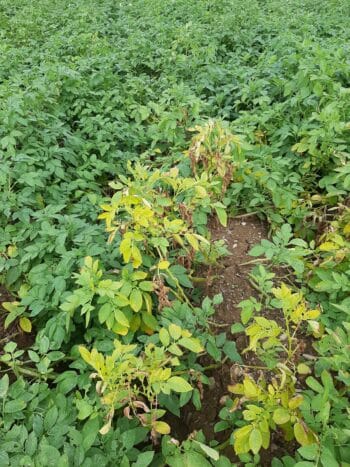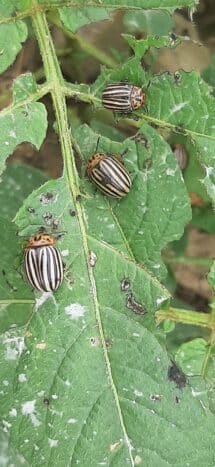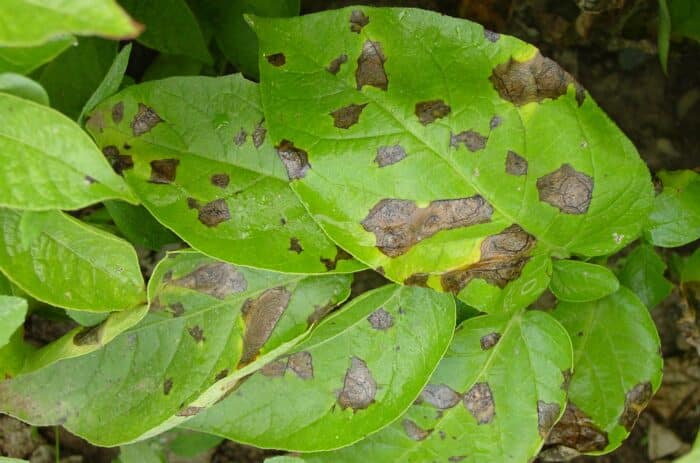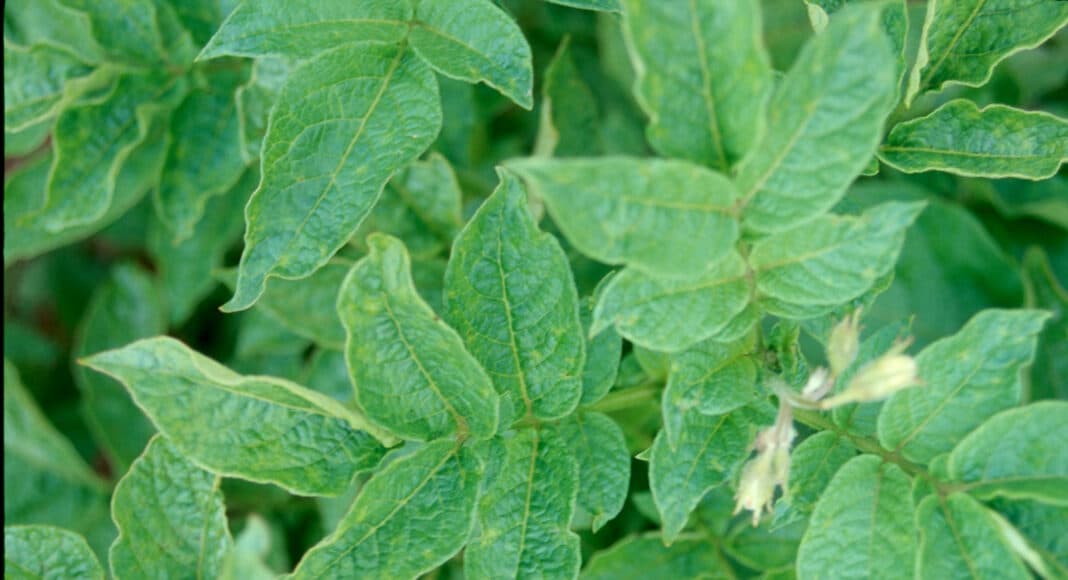Pests and diseases to watch out for this season.
Last year was a challenging year for many Canadian potato growers. Depending on the region, growers faced a variety of diseases, multiple pests, excessive wet and too much dry. While every year brings its own challenges, some factors in one growing season can influence the next. We sat down with researchers from across the country to get a feel for what 2024 may bring. Their answers may surprise you.
Alberta
Despite a relatively straightforward 2023, farmers should not assume they can rest easy on the pest and disease front heading into spring planting. That’s the advice from Dmytro Yevtushenko, associate professor of Biological Sciences at the University of Lethbridge.
Part of the Potato Pest Monitoring program, Yevtushenko works with university students, the Alberta Potato Growers and Promax Agronomy Services on early detection to help farmers make timely management decisions and reduce chemical application.
The vacuum traps in farmers’ fields collect spores while Yevtushenko’s team analyzes them annually from May to September. They test for Phytophthora, Alternaria and Fusarium species. While Alternaria was higher than normal, Fusarium was down. No threat from late blight was detected; in fact, it’s at the lowest observable levels he’s ever seen.
Yevtushenko is also investigating potato early dying, which he says, “is among the top priorities and will stay here with us for many years.”
He’s also focused on a two-year study of powdery scab of potatoes, a disease he believes is on the rise.
Over the winter, Yevtushenko visited potato storages in the province to sample and observe Fusarium species.
“Dry rot continues to present major storage issue in potato in Alberta,” he says, adding it’s often seen by springtime, but not recently. “I saw it in November, so that’s relatively early and it can create problems.”
The El Niño effect may also cause big issues for farmers in 2024.
“It is possible that pathogen pressure could be higher because of our unusually warm [winter]. Insect pests and pathogenic microorganisms survive in the mild temperatures better.”
Currently, Colorado potato beetle is of less concern in Alberta relative to other provinces. Green peach aphid is also a low concern, Yevtushenko says.
Even though no bacterium was discovered during sampling, Yevtushenko stresses close monitoring for potato psyllids. The minute pests are vectors for the zebra chip bacterium, which causes striped discoloration of harvested potatoes.
Overall, farmers are doing well and do not need to make significant adjustments in 2024.
Yevtushenko’s advice is: “Just to stick to the normal agricultural practices — rotation cycles, applications of chemicals and integrated pest management. All this should reduce the disease incidence in the fields.”

Manitoba
Thanks to a quiet 2023 for foliar diseases courtesy of dry conditions, this spring may bring lower than average levels of inoculum at planting time, says Vikram Bisht, a pathologist for potatoes and horticulture crops for the provincial government, based in Carman, Man.
Pest wise, however, farmers should be extra vigilant. Some producers fought significant populations of Colorado potato beetle, especially in southern Manitoba, last year. The insect has been recorded resistant to a few insecticide groups including neonicotinoids (Group 4) and spinosyn (Group 5).
“At the moment, the potato industry is again looking for newer effective chemistries,” says Bisht.
Green peach aphid populations in 2023 were huge in some fields. Some traps recorded more than 100 aphids per week, which was between five- and 10-times recent years’ findings.
“You can imagine if you’re trapping about 100 aphids per week, you will actually have a significantly huge population in the field,” Bisht says, adding that Minnesota had similarly large numbers.
With that in mind, Bisht says seed potato growers must be aware that — if aphid populations are trending high — not to extend the crop past the third week of August.
The single biggest disease to watch for in 2024 is potato early dying.
“The inoculum in the form of microsclerotia of the Verticillium fungus can survive in these fields for many years, even in the absence of the host, plus it has a wider host range,” he says.
Bisht reminds farmers that if they receive rainfall following tuber initiation leading to wet soil, expect pink rot, which causes storage issues. On fields with a history of pink rot, apply foliar phosphorus acid fungicide at about eight l/ac for effective control against both pink rot and late blight. Phosphorus acid products can be applied to potatoes going into storage.
Late blight inoculum remains very low but has the potential of entering through infected tomato seedlings, as happened in 2010. Fungicide applications based on late blight risk forecasting helps support the judicious use of fungicide and may even help reduce total applications.
Bisht reminds farmers to be on the lookout for powdery scab, which can transmit potato mop top virus (PMTV). This disease leads to internal browning and causes losses for both growers and processors. Tolerant varieties are commercially available.
“The choice of the varieties for a field with potential mop top is quite important,” notes Bisht.
Ontario
Dennis Van Dyk says this past year will be one that “will be remembered for quite awhile,” by farmers given intense disease pressure in potato fields, largely driven by weather.
A vegetable specialist with OMAFRA, Van Dyk says 2023 started dry but, when rain came near the end of June, it never really stopped.
“We had our highest late blight pressure year in a long time,” he says, though he points out that the disease impacted certain regions rather than the entire province. “Growers were able to manage it with fungicides, so that’s always good and beneficial when the tools actually work.”

Van Dyk says he expects 2024 will bring higher than normal late blight pressure, likely because mild winter weather conditions mean higher levels of inoculum will successfully overwinter, and because inoculum may potentially be on seed.
“Prioritizing those late blight BMPs [best management practices] is going to be huge going into next year,” he says.
Be on the lookout for common scab too, especially in fresh market potatoes. Over the wet 2023, there were storage pathogen issues, namely soft rot, leak and pink rot. Farmers’ “really good management going into storages” likely prevented more issues, explains Van Dyk.
On a more positive front, there will likely be less potato early dying (PED) compared to recent years. BMP recommendations outlined in a nationwide PED project are being embraced by farmers.
“A lot of growers are actually implementing [the BMPs] and that probably had a positive impact,” Van Dyk says. Some of the recommendations include the use of bio-fumigants such as mustard, and the use of longer rotations and cover crops, including arugula, rye, sorghum-Sudan grass and more.
Pest-wise, 2023 proved relatively flat. However, leafhoppers must be closely watched because once they are discovered, it’s almost too late to spray. Colorado potato beetle likely presents the biggest risk, especially considering growing resistance among certain populations.
“It’s still important to mix chemistries because you don’t know what your neighbour’s been using,” Van Dyk says. Group 28 products are the most popular foliar option, but he also recommends Group 5, 6, 15 and 30 for control if you use a Group 4 at planting.
New Brunswick
Farmers are heading into the 2024 growing season following a decidedly average year in 2023. The season started well enough, but torrential rains and warm weather not seen in three-plus decades battered the upper river valley portion of the province. While some areas had terrific growing conditions, the harder hit areas pulled the province’s potato yield and overall quality back down to average.
“[There were] several periods of excessive precipitation, far exceeding field capacity or the crop’s ability to efficiently utilize the available moisture,” says Khalil Al-Mughrabi, a pathologist and program lead, science and innovation, at the Potato Development Centre in Wicklow, N.B. “It resulted in many fields having issues such as hollow heart and pythium leak.”
The streak of no late blight now stretches to six years. That said, early blight was a concern in 2023, and Al-Mughrabi thinks it may be an issue again in 2024, in part due to climate change.
“Alternation between wet and dry weather conditions stresses the potato foliage and makes it more susceptible for infection with early blight,” he says.
There are registered fungicides available for early blight and late blight in tandem, or early blight on its own.
Green peach aphids are a pest to watch this growing season following substantial aphid population increases last year. Al-Mughrabi speculates that shifting weather patterns will make it easier for the pest to successfully overwinter, something it hasn’t really been able to do before.
“Growers were encouraged to use oils in addition to insecticides in order to kill the aphids and reduce the spread of PVY [potato virus Y] in potato fields,” he says. “Insecticides alone will not stop the spread of the virus via aphid vectors.”

Prince Edward Island
Island farmers experienced a dry, cool start to 2023 but ended with very wet harvest conditions. In fact, Ryan Barrett, research and agronomy specialist with the P.E.I. Potato Board, says it was the wettest growing season on record in the Charlottetown region of the province. Certain farmers were still harvesting as late as Nov. 10.
As spring planting approaches, Barrett says farmers should watch for volunteer potatoes, especially if winter conditions stay mild. Volunteer diseases include late blight and PVY (potato virus Y).
“If we get a couple of good cold snaps and some good frost in the ground, that will be less of an issue,” he says.
Once the year begins, however, managing disease and pest pressures will largely be a matter of watching changing climatic conditions and responding quickly if an issue presents itself. This proved a challenge for many in 2023.
“This past year, growers just couldn’t get sprays on at the time that they wanted because the weather wasn’t good. That led to some issues with early blight and brown spot in some varieties,” Barrett says. The good news, he adds, is that, “increasingly, growers are getting better and better and more sophisticated all the time at managing those things.”
Barrett cautions growers to watch for Colorado potato beetle, especially as they have demonstrated resistance to neonicotinoid seed treatments. Thankfully, farmers have several pesticide group options for control.
Wireworm levels are trending down. A contributing factor to this positive trend is rotational changes in many fields, and the increasing planting of specific crops such as buckwheat and brown mustard.











